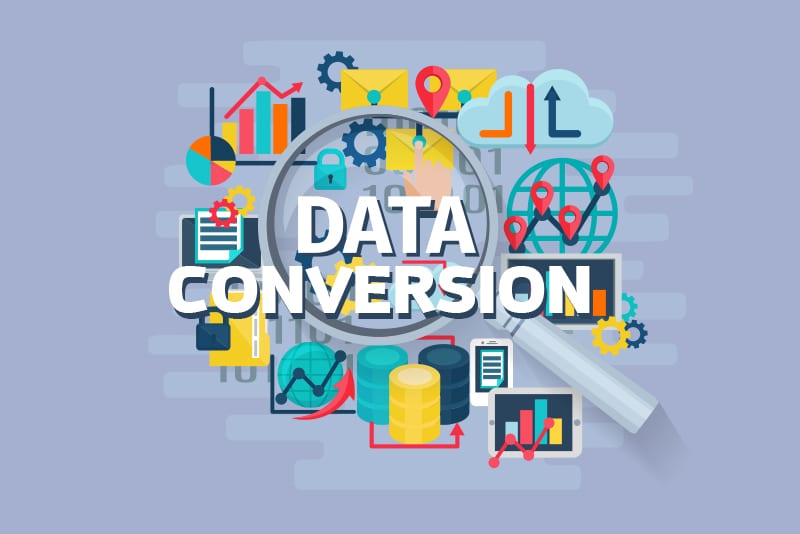Data conversion is the process of converting data format in one format into another. The main aim is to make the data compatible with a different application or system, while ensuring that the data is accurate, complete, and usable by purpose for which it was intended. The process of data conversion is complex and time-consuming, and comes with many challenges, from data quality and compatibility issues to resource constraints and data security concerns. Data conversion outsourcing to an expert is the best way for companies to ensure accuracy, save time, and streamline the process.
Importance of Data Conversion
Businesses collect huge volumes of data and need to utilize it effectively to stay competitive in the modern world. The development of advanced digital technologies has led to data being generated across multiple channels. Leveraging this information is critical to:
- gain insights into customer behavior
- develop new products
- optimize operational efficiency
- improve decision-making,
- create new business models to maximize value, and
- make data-driven decisions to drive innovation and growth
Data conversion companies help businesses achieve these goals by ensuring that the data is accurate, complete and usable by target systems and applications. When data is converted into the desired format, businesses can effectively analyze, process, and utilize it for various purposes.
Looking to convert your data to newer formats? Reach out to Managed Outsource Solutions for efficient and affordable data conversion services!
Basic Steps in the Data Conversion Process
Data conversion can transform data from an old legacy system to a new system, or integrate data from multiple sources into a single unified format. There are various types of data conversion such as XML conversion, PDF conversion, image to text conversion and numerous others. Though the steps in the data conversion process may vary based on the specific project requirements, they generally comprise the following:
- Define the conversion requirements: The first step is to identify and document the specific data formats and structures required for the target system or application. Determining the necessary data mapping and transformation requirements involves the following:
- Determining the target data format and identifying the source data format.
- Analyzing the differences between the source and target data formats
- Identifying the necessary data transformations
Once these steps are completed, you need to document the specific steps required to convert the data and identify any constraints or limitations that may impact the data conversion process.
- Evaluate the source data: This step entails assessing the source data you want to convert by analyzing its quality, completeness, and consistency. This includes:
- identifying missing or duplicate data, inconsistent data formats, or outliers
- evaluating source data quality by checking for data accuracy, completeness, and consistency
- data validation, data cleansing, or other data quality measures to address any issues
- making sure the source data is appropriate for the target system or application, identifying data fields or elements that are not relevant and any gaps to be addressed.
- mapping the source data fields correctly to the target data fields
Any sensitive or confidential information in the source data should also be identified so that it can be protected during the data conversion process.
- Extract the source data: The next step is extracting the data from the source system or application and storing it properly. Data extraction from the source requires careful planning and execution. It involves:
- identifying the specific data sources for extraction and choosing the appropriate data extraction method
- defining the steps involved in extracting the data, including whether data cleansing services are needed to correct any quality issues
- Executing the data extraction process, validating the extracted data to ensure that it is complete, accurate, and relevant
The extracted data should be then stored in a temporary location until the conversion is done.
- Convert the data: Once the source data has been extracted using the defined steps and data extraction method, it is converted to the target format and structure. Data transformations to convert the source data may include data mapping, data cleansing, data enrichment, or data normalization.
- Load the transformed data: Data transformation tools or scripts are used to load the converted data into the specific application or system. The process could include using APIs, file transfers, or direct database connections, and usually requires technical expertise to complete successfully.
- Validate the data: Next, data validation tests and checks are done to ensure that the data is accurate, complete, consistent, and meets the necessary quality standards. Data validation aims to identify errors and inconsistencies in the data and prevent them from affecting the reliability of subsequent processes
- Clean up and maintain the data: At this stage, any inconsistencies or errors in the data are addressed. Data maintenance procedures are also defined to ensure data integrity and accuracy.
- Test the converted data: Testing is an important step to ensure that the converted data works correctly and seamlessly within the target system or application. After a set of data is prepared for testing, different types of tests such as unit testing on individual components, integration testing, regression testing, and user acceptance testing will be performed to ensure that the converted data is ready for use in the target system or application.
- Deploy the converted data: This is the final step in the data conversion project and requires careful planning and attention to detail. It involves moving the converted data from its present location to the intended database, file system, or application. The deployment is tested to ensure that it works correctly. The deployed data is validated to ensure that it is stored and retrieved correctly, and meets the expected quality standards.
Data conversion is a complex task, especially when it involves complex data formats. If it is not executed properly, it could also lead to loss of information. Partnering with an experienced data conversion company can help businesses complete the process securely and successfully and harness the power of data to succeed in today’s competitive landscape.




